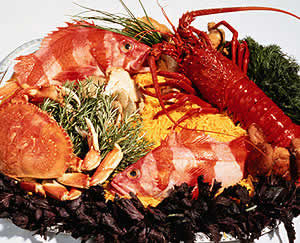Fit and Fast Recipes

Related Topics
- By Linda Knittel
Selecting Safe & Healthful Seafood
When chosen carefully, fish is an excellent source of protein, with much less fat and cholesterol than lean meat.
How healthful is fish?
Fish is a great source of lean protein and one of the best ways to get a healthy dose of omega-3 fatty acids, those good fats that protect your heart, support your brain, and keep your cells healthy. However, since our oceans and rivers are not as clean as they once were, not all fish is equally healthy. The tips in this article will help you make safe and healthful seafood choices.
Should I buy wild fish or farmed fish?
This is a complex question. The demand for seafood has encouraged many fisheries to catch more fish than our waters can sustainably produce, resulting in diminishing fish stocks and damage to the ecosystem. For that reason, fish farming seems a logical solution. However, not all farmed fish are thought to be healthy. For example, farmed salmon has been shown to contain chemical pollutants. On the other hand, farm-raised trout, catfish, shrimp, striped bass, sturgeon, Artic char, and flounder are healthy and sustainable choices.
To help you make educated choices, ask your seafood supplier where the fish came from and how it was caught.
How do I select seafood?
When chosen carefully, fish is an excellent source of protein, with much less fat and cholesterol than lean meat. Plus, fish is loaded with heart-healthy omega-3 fatty acids, which have been shown to decrease the risk of heart disease, lower high cholesterol, ease arthritis, and improve mood. Follow these tips when shopping for fish:
- Look for the “Seafood Safe” label, which indicates that the item is tested regularly for PCBs and mercury and that it meets quality-assurance guidelines for that species. Visit www.seafoodsafe.com for a list of participating fish distributors.
- Check out www.oceansalive.org for an up-to-date listing of which fish varieties are healthiest.
- Know that fish high on the food chain such as swordfish, shark, tuna, king mackerel, and lobster may contain higher levels of contaminants. Limit eating canned tuna to once a month.
- If you are not sure about a fish don’t eat it.
What looks good?
- When buying fish, choose firm, shiny flesh that will spring back when touched.
- Fish should have only a mild smell, like seawater, but not a strong fishy odor.
- Shellfish, such as oysters, clams, and mussels, must be alive when purchased.
- Lobsters and crabs should be alive or frozen when purchased.
- Shrimp are usually frozen and often precooked. Look for a full shell and firm meat.
- Frozen fish is a good choice, as freezing keeps water inside fish tissues, thus preserving juices and maximizing flavor and texture when cooked. Frozen fish should be somewhat shiny and have no white freezer-burn spots.










